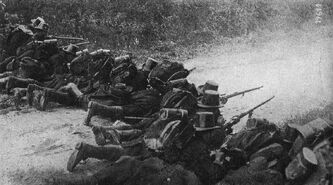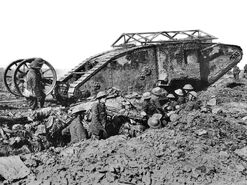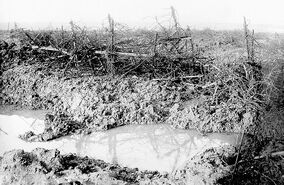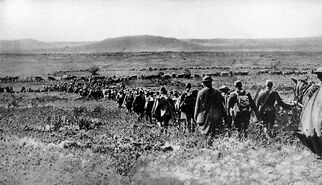| The following page is under construction.
Please do not edit or alter this article in any way while this template is active. All unauthorized edits may be reverted on the admin's discretion. Propose any changes to the talk page. |
The Great War was waged primarily in Europe from 1914 to 1919, but spilled over into Africa, the Middle East, and the Atlantic, Indian and Pacific Oceans.
On one side of the war were the Central Powers: Austria-Hungary, Germany, Bulgaria, and the Ottoman Empire. The major Allies consisted of the British and French Empires, the Russian Empire (until 1917), Italy, Japan, and after 1917 the United States.
World War One saw the first major use of poison gas, large artillery, armored tanks, and airplanes. It was a "total war" because the governments involved took control over the economy and factories, giving first priority to the goods needed for war. Wage and price controls were imposed, there was rationing of goods for civilians, and free speech was limited. The governments put out propaganda to maximize support for the war and dislike of the enemy. Many of the techniques of population manipulation and central government control which we see today were first pioneered by European powers during The Great War.
Causes[]

June 28, 1914. Archduke Franz Ferdinand, heir to the Austrian Empire, is assassinated.
The causes of the Great War range from the immediate to the remote. While some historians believe the war to have been accidental, others have said that the accumulating factors made it inevitable.
The rise of Germany, for instance, was seen as a threat by the French and British. Germany, unified in 1870, defeated France in the Franco-Prussian War and annexed Lorraine and Alsace. Afterwards, Germany became a serious rival for the British, starting a naval arms race.
In Eastern Europe, meanwhile, Austria and Russia contended with one another over interests in the Balkan Peninsula.
The final nail in the coffin, however, would be when Serbian Black Hand terrorist Gavrilo Princip killed Austrian heir Archduke Franz Ferdinand and his wife Sophia. The Germans immediately came to Austria's side, but Russia sided with their Slavic cousins, the Serbs.
Soon, France, who was in an alliance with Russia, ordered a state of mobilization. This prompted Germany to send its army into Belgium, which made Britain take part in the conflict.
1914[]
| JUNE 28 |
Black Hand terrorist Gavrilo Princip assassinates Archduke Franz Ferdinand at Sarajevo. |
|---|---|
| JULY 28 | The Austrian Empire declares war on Serbia. |
| JULY 29 | The Russian Empire begins mobilization. |
| JULY 30 | The German Empire begins mobilization; orders Russia to cease. |
| AUGUST 1 | Germany and Russia declare war on one another. |
| AUGUST 3 |
Germany invades Belgium; declares war on France. German cruisers Goeben and Breslau bombard French harbors in North Africe |
| AUGUST 4 |
The British Empire declares war on Germany. The United States declares itself neutral. |
| AUGUST 6 |
Austria declares war on Russia. |
| AUGUST 7 | First British troops land in France. |
| AUGUST 10 | The Göben and Breslau reach the Dardenelles, after escaping the Allies. |
| AUGUST 12 |
France and Britain declare war on Austria. |
| AUGUST 17 |
Russia invades East Prussia. |
| AUGUST 20 |
Brussels falls to the Germans.
Russia captures Gumbinnen. |
| AUGUST 22 |
Swift German victory at Ardennes. |
| AUGUST 23 | Japan declares war on Germany. |
| AUGUST 24 |
British defeat at Mons. |
| AUGUST 30 | Count Paul von Hindenburg captures 125,000 Russians at Tannenburg. |
| SEPT. 7 |
Russians routed at the Masurian Lakes. |
| SEPT. 9 |
French victory at the Marne. |
| OCT. 9 |
Germany lays siege to the Polish city of Ivangorod. |
| OCT. 10 | Fall of Antwerp to German forces. |
| OCT. 17 |
Russian reinforcements prevent the capture of Warsaw. |
| OCT. 23 |
Germany withdraws from Ivangorod. |
| NOV. 18 |
German advance halted at Lodz. The Goeben is damaged after encountering a Russian squadron in the Black Sea. |
| NOV. 22 |
The First Battle of Ypres ends with no clear victor. |
| DEC. 2 |
Austria captures Belgrade. |
| DEC. 15 |
Serbs retake Belgrade. Austria withdraws from Serbia. |
1915[]
| JAN. 1 |
Karl Liebknecht and Rosa Luxembourg announce the formation of the Spartacusbund. The Spartacusbund carries out a string of clandestine terrorist attacks against Germany. |
|---|---|
| FEB. 4 |
Germany declares British territorial waters a warzone, begins unrestricted submarine warfare |
| FEB. 22 |
Germany shells Rheims. |
| MARCH 22 |
Zeppelins attack Paris. Przemsyl captured by Russia. |
| APRIL 22 |
Germans use chlorine gas against the Allies at Ypres. |
| MAY 1 |
American tanker Gulflight is sunk by a U-boat off of the Scilly Isles. |
| MAY 3 |
Spartacusbund operative Werner Schmiel is arrested in an abortive attempt on the life of the kaiser. |
| MAY 7 |
The Cunard liner RMS Lusitania is torpedoed off of Ireland by German U-boat U-20. 1,198 people die; 123 American citizens are among them. |
| MAY 23 |
Italy declares war on Austria. |
| MAY 31 | First zeppelin attack on London. |
| JUNE 3 |
Przemsyl retaken by the Central Powers. |
| JUNE 20 | Meuse-Argonne Offensive begins. |
| JULY 13 | German operations in the Argonne end. |
| AUGUST 5 |
Germany captures Warsaw. |
| AUGUST 7 |
German advance halted at Riga. |
| AUGUST 19 |
The White Star liner RMS Arabic is torpedoed off of Ireland by U-boat U-24. Forty-four dead, three Americans among them. German-American relations are further strained. |
| AUGUST 26 | Germany siezes Brest-Litovsk. |
| SEPT. 3 |
Czar Nicholas II dismisses Grand Duke Nicolae and personally takes command of the Russian military. |
1916[]
| JAN. 15 | The Greek government permits the Allies to use Lemnos as a base. |
|---|---|
| FEB. 1 | Start of Operation Troy: A revised invasion plan against the Ottoman Empire. The first wave of British naval attacks on Turkish forts along the Dardenelles. Small amphibious landings are carried out. |
| FEB. 12 | Troy. Second wave of British attacks on Turkish outer defenses. Turkish long-range guns are silenced. |
| FEB. 14 | Troy. An attempted naval assault between the straits is hampered by Turkish artillery. |
| FEB. 21 | Start of the Battle of Verdun. |
| FEB. 26 | The Mediterranean Expeditionary Force departs Egypt. |
| MARCH 8 | The British and French commanders agree to a ground assault in the Dardenelles. |
| MARCH 14 |
Troy. Australian and New Zealand (ANZAC) forces land at Beach Z on Cape Hellas; take the Sari Bair Ridge. Heavy casualties from Turkish machine guns as the British land on Beaches S, V, W, X, and Y. Sedd el Bahr falls to the British. French forces land at Kum Kale. |
| MARCH 15 |
Troy. The British and French take Krithia. The French make a beachhead at Alexandretta, in eastern Turkey. The British land troops at Dortyol. |
| MARCH 17 | ANZACs reach the Outskirts of Maidos. |
| MARCH 19 |
Troy. British and ANZAC forces surround the plateau of Kilid Bahr. The French in the east advance to Karakese. |
| MARCH 21 |
Verdun. The Germans capture the French village of Vaux. Troy. Allied advance in Gallipoli halted by the Turkish XIX Division. Stalemate begins. |
| APRIL 4 | Alexey Brusilov becomes commander of Russia’s Southwestern Front. |
| MAY 21 | Spartacusbund demonstration in Dusseldorf disrupted by machine guns. |
| MAY 31 - JUNE 1 | Battle of Jutland. |
| JUNE 4 | Start of the Brusilov Offensive. |
| JUNE 6 |
Lutsk falls to the Russians. Troy. British guns at Kilid Bahr exchange salvos with Turkish artillery at Chanak Kale. |
| JUNE 18 | Russia takes Czerniowce. |
| JULY 1 | Start of the Battle of the Somme; the French make gains at Hardecourt. |
| JULY 10 | Somme. The British capture Contalmaison. |
| JULY 26 | Somme. Delville Wood recaptured by the British. |
| AUGUST 17 |
Russia defeated at Kowel. Verdun. France retakes Fleury. |
| AUGUST 18 | Somme. The British advance to Guillemont. |
| AUGUST 24 | Somme. The French capture Maurepas. |
| AUGUST 27 |
Austria invades Transylvania. Romania declares war on the Austrian Empire. |
| SEPT. 15 | Somme. The tank makes its debut at Flers. The British forces advance. |
| OCT. 10 |
Transylvania falls to the Austrians and Germans. Somme. France gains three miles near the Somme. |
| NOV. 2 | Verdun. France retakes Vaux. |
| NOV. 7 | Woodrow Wilson re-elected President of the United States |
| NOV. 13 | Somme. Beaumont Hamel and Beaucourt fall to the British. |
| NOV. 18 | The Battle of the Somme ends. |
| NOV. 26 | The British hospital ship HMHS Britannic sinks in the Kea Channel after hitting a mine. |
| DEC. 17 | Grigoriy Rasputin, a self-proclaimed faith healer, is murdered by a trio of nobles in hopes of salvaging the prestige of House Romanov. |
| DEC. 18 | Verdun. France recaptures Fort Douaumont. The battle ends. |
1917[]
The year 1917 saw the end not only of the Ottoman Empire, but Russia as well.
| JANUARY | Troy. Beginnings of terrorist activity in Anatolia. Sultan Mehmed V gradually shifts troops to combat the militants. |
|---|---|
| JAN. 2 | Troy. Islamists strike in Constantinople, Edirne, Izmir, Adana, Ankara, and Kocaeli, attempting to torch churches, army garrisons, and hospitals. |
| JAN. 3 | Greece declares war on the Central Powers. |
| JAN. 5 | Troy. "The Great Effendy", the leader of Turkish jihadists, announced holy war against the infidels in Turkey. |
| JAN. 9 | Troy. The French forces withdraw from Gallipoli; rerouted to Cicilia. |
| JAN. 15 | Troy. Fighting between jihadists and Turkish regulars in Anatolia. |
| JAN. 19 |
The Zimmermann Note, a letter from the Germans to the Mexican government which promised the return of the territory annexed by America during the Mexican War in return for joining the Central Powers, is intercepted by British agents. Troy. Jihadists clash with French forces in Adana. |
| FEB. 3 |
U-boat sinks American grain ship Housatonic. The US ends relations with the German Empire. Troy. The Allies begin search-and-destroy operations against jihadists, Operation Giaur. |
| FEB. 9 | Giaur. Allies set up base of operations in Alexandrette; systematically secure surrounding townships over the next few days. |
|
FEB. 10 |
Troy. Jihadists attack Ottoman troops at Sinop. |
| FEB. 25 |
The Cunard liner RMS Laconia is torpedoed off of Ireland by U-boat U-50. Twelve are dead, two Americas among them. |
| MARCH 1 |
The Zimmermann Note is made known to the American public. Giaur. Mustafa Kemal transferred to Asian Turkey to fight the jihadists. |
| MARCH 8 |
A series of strikes erupt in the Russian capitol of Petrograd. |
|
MARCH 12 |
Russian soldiers sent to break up the Petrograd riots join the uprising. |
| MARCH 14 |
The Russian Duma, seeing that the czar had lost all credibility, sets up the Russian Provisional Government (RPG) with Prince Georgiy Lvov as prime minister. Giaur. The Allies secure Tarsus. |
| MARCH 15 |
The Russian Empire is dissolved upon the abdication of Czar Nicholas II. Giaur. French troops trapped in ambush battle southeast of Trabzon. |
| MARCH 20 |
Giaur. Kemal's unit hits the jihadists hard at Rize. The British establish an outpost at Iluh. |
| MARCH 22 |
Giaur. Kemal captures number two jihadist leader Tunga Olmez at Bayburt. The United States and the Allies recognize the RPG. |
| MARCH 23 |
Troy. British forces advance into Thrace. Giaur. Jihadist attack on the Iluh base thwarted. |
| MARCH 29 | Giaur. Intelligence delivered to Kemal leads to the capture of Aysu Sunter and thirty-five jihadists at Pazar. |
| APRIL 2 | Giaur. Jihadists attempt to drive the British from Iluh for a second time. Among the captured is Gokmen Karasu, who reveals the hideout of Effendy at Ispir. |
| APRIL 6 |
The US Congress formally declares war on Germany. |
| APRIL 7 | Giaur. British and French forces surround Ispir. |
| APRIL 8 - 9 |
Giaur. Allied shelling begins at midnight on April 8. Effendy killed by shrapnel. Troy. Greek troops land at Suvla Bay. |
| APRIL 9 |
Beginning of the Arras Offensive. The Canadians storm Vimy Ridge. |
| APRIL 16 |
France commences the Nivelle Offensive. The German High Command ships Communist radical Vladimir I. Lenin to Petrograd by train. Giaur. Ispir falls; jihadist defenders overwhelmingly commit suicide rather than face capture. |
| APRIL 17 |
Troy. The British and Greeks take Tekirda. The first instances of mutiny in the French army, which intensify later. |
| APRIL 18 |
The French capture Chemin des Dames. Troy. The Royal Navy pushes its way into the Sea of Marmara. |
| APRIL 18-22 | Troy. British ships systematically destroy Ottoman defenses along the Sea of Marmara. |
| APRIL 24-25 | Greek forces clash with the Bulgarians near the Salonika border. |
| APRIL 30 |
Troy. The British and Greeks close in on Constantinople |
| MAY 2 | Troy. The Ottomans repulse the first wave of British attacks. |
| MAY 3 | Troy. Allies retreat to Corlu. |
| MAY 9 |
Troy. Ottomans fall back to Catalca. The Nevelle Offensive ends in failure. |
| MAY 16 | The Arras Offensive ends. |
| MAY 20 |
Troy. Greeks advance to Danamandira. |
| MAY 25 | Troy. The British advance to Hastane. |
| JUNE 7 |
The British capture Messines Ridge. Troy. Second bombardment of Constantinople begins. |
| JUNE 10 | Troy. Sultan Mehmed V abdicates. |
| JUNE 12 | Troy. The Ottomans surrender. |
| JULY 17 | The July Days, an attempt to overthrow the RPG fails; Lenin flees to Finland. |
| JULY 19 |
Georgiy Lvov steps down as prime minister of the RPG. Aleksandr Kerensky succeeds him. |
| JULY 31 | Beginning of the Third Battle of Ypres. |
| AUGUST 1 |
Brusilov is replaced by Lavr Kornilov as commander-in-chief of the Russian military. |
| AUGUST 3 | Austria recaptures Czernoiowce. |
| AUGUST 10 |
III Ypres. The British direct attacks against the Gheluvelt Plateau. |
| AUGUST 22 |
III Ypres. The British advance halted on the Menin Road. |
|
SEPT. 5 |
German forces capture Riga from the Russians. |
| SEPT. 8 | Kerensky dismisses Kornilov; Mikhail Alexeev replaces him as Commander-in-Chief; Kornilov stages a coup d'etat against Kerensky. Kerensky arms the Bolsheviks in desperation. Kornilov is arrested. |
| SEPT. 20 | III Ypres. The British renew the attack on the Gheluvelt line. |
| SEPT. 26 | III Ypres. The British launch an attack at Polygon Woods. |
| OCT. 4 | III Ypres. The Germans are driven from Broonseinde. |
| OCT. 9 | III Ypres. The British assault on Poelcappelle is hindered by rain and mud. |
| OCT. 12 | III Ypres.
Germany fends off Allied attack on Passchendale. |
| OCT. 26 | III Ypres. The Allies capture Passchendale. |
| NOV. 6 | Kerensky flees Petrograd in an armored car provided by the American Embassy. |
| NOV. 7 |
The RPG is dissolved by a Bolshevik putsch led by Leon Trotsky. |
| NOV. 20 |
Beginning of the Battle of Cambrai. Tanks enable the British to make gains. |
| NOV. 22 | Cambrai. Fontaine captured by the Germans. |
| NOV. 26 |
The Bolshevik government sues for peace. |
| NOV. 27-30 |
Cambrai. The Germans fend off numerous allied counterattacks and negates the British gains made on the 20th. |
| DEC. 4 |
The Battle of Cambrai ends. |
| DEC. 6 |
Finland declares itself independent of Russia. |
| DEC. 9 |
Treaty signed between the Central Powers and Romania. |
| DEC. 15 |
Ceasefire between Red Russia and Germany. |
| DEC. 23 |
Moldova declares itself independent of Russia. |
1918[]
1918
| JAN. 2 | Formation of the Republic of Turkey; Mustafal Kemal selected as prime minister. |
|---|---|
| JAN. 11 | New Turkish capital established at Ankara; Turkey declares neutrality. |
| FEB. 9 |
The Treaty of Brest-Litovsk ends Russian participation in the Great War. |
| FEB. 16 | Lithuania declares itself independent of Russia. |
| FEB. 18 |
Germany resumes war with Russia. |
| FEB. 24 |
Estonia declares itself independent. The Bolsheviks bow to Germany’s terms. |
| MARCH 3 | Germany takes Kiev. |
| MARCH 13 |
The Germans occupy Odessa. |
| MAY 10 | Germany uses gas against the Americans and French in the Meuse-Argonne sector. |
| MAY 20 | Kaiser Wilhelm II narrowly avoids assassination by Spartacist Ludwig Wagner. |
| MAY 28 |
American troops storm Cantigny. |
| MAY 29 |
Germany occupies Soisonnes. |
| JUNE 3 |
The Americans halt the Germans at Chateau-Thierry. Kaiser Wilhelm II is killed when a bomb is thrown into his carriage by Spartacist operative Otto Fromann. |
| JUNE 4 | Crown Prince William declared Kaiser Wilhelm III. |
| JUNE 25 |
The Americans drive the Germans from Belleau Wood. |
| AUGUST 1 |
France retakes Soissons. |
| AUGUST 28 |
Canada breaks through the Hindenburg Line. |
| SEPT. 16 |
The Americans capture St. Mihiel. |
| SEPT. 26 |
The Argonne Offensive begins. |
| OCT. 10 |
The Americans force Germany to withdraw from the Argonne. |
| OCT. 11 | Pivotal German railroad center at Sedan falls to the Americans. |
| NOV. 3 | Austria surrenders. |
| NOV. 9 | The Spartacists proclaim the German Free Socialist Republic. |
| NOV. 11 |
Poland declares itself independent, joins the Allies. |
| NOV. 27 | The British recaputre Liege. |
| DEC. 1 | The French, British, and Belgians retake Brussels. |
| DEC. 7 |
The Germans are pushed back to the Scheldt River. |
| DEC. 8 |
The Americans occupy Metz. The British and French begin the Siege of Antwerp shortly before midnight. |
| DEC. 9-10 |
Antwerp. Anglo-French artillery fire on German-held Antwerp. The A7U-V makes its debut in the battle. |
| DEC. 10 | The Spartacusbund stages a demonstration in Berlin. |
| DEC. 14 | Antwerp. German forces evacuate Antwerp. |
| DEC. 15 |
The Americans advance into Alsace and Luxembourg. German Commander Ludendorff calls for an armistice. |
| DEC. 18-19 | American General Pershing begins making plans for Operation Siegfried, the invasion of the German Empire. |
| DEC. 21 | American President Wilson demands an end to unrestricted U-Boat activity and a withdrawal of all German forces from occupied territory. |
1919[]
| JAN. 6-9 |
The Allies conduct bombing runs on Cologne. |
|---|---|
| JAN. 8 | Kaiser Wilhelm III abdicates; end of the German Empire; Spartacists take control. |
| JAN. 10 | The Spartacists begin negotiations with the Allies. |
| JAN. 20 | The Compiègne Armistice is signed between Spartacist Germany and the Allies. |
Aftermath[]
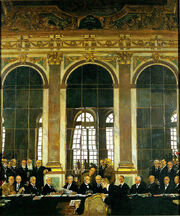
Signing the Treaty of Versailles.
The guns on both sides fell silent at 1:44PM Paris Time, on January 20. Intensive peace negotiations would follow.
The Paris Peace Conference[]
The peace conference opened in Paris in March 1919 with seventy delegates representing twenty-seven victorious nations. The general optimism and idealism had been greatly strengthened by President Wilson's peace manifesto, the Fourteen Points, which stressed national self-determination and the rights of smaller countries.
The real powers at the conference were the United States, France and Great Britain. Germany was not allowed to participate. Italy was considered one of the Big Four, but its role in the conflict was quite limited. Almost immediately, the three major Allies started to quarrel. Wilson, cheered by the Europeans as the spokesman for international democracy, was obsessed with creating the League of Nations. The American president firmly believed that such an organization would protect member states from aggression and avert future wars. British Prime Minister Lloyd George, on the other hand, was more concerned about punishing Germany; France's Georges Clemenceau shared the same sentiment.
France, fearful of another German invasion, demanded a permanent demilitarization of Germany and a buffer state between them. Unable to convince anyone to agree to this motion, Clemenceau compromised with a military alliance with the US and Britain.
The Treaty of Versailles.[]
The Treaty of Versailles between the Allies and Germany was the key to the settlement, and the terms were not unreasonable as a first step toward re-establishing international order. Germany’s colonies were given to Britain, France, and Japan as League of Nations mandates. Germany’s losses within Europe were minor, thanks to Wilson. Alsace-Lorraine was returned to France. Parts of Germany inhabited by Poles were ceded to the new Polish state. The city of Danzig was also placed within Polish tariff lines, but was given full autonomy with the protection of the League of Nations. Furthermore, the Rhineland was declared a demilitarized zone, and the Germans were to limit its army to 100,000 soldiers, minimize its navy, and dismantle all aircraft.
More harshly, the Allies declared that Germany (with Austria) was responsible for the war and had to pay for all reparations for the war and for all damages to civilian property. This unfortunate and often-criticized clause expressed the virulent desire to punish Germany, but the actual figure was never set, and there was always the possibility that it would be once the anger had settled.
The German representatives protested the move, claiming that it had been done under an imperialist government, but their voices fell on deaf ears. However, they had no choice, because the Allies had yet to lift their naval blockade. On July 22, 1919, representatives from the Spartacist government signed the treaty in King Louis XIV’s Hall of Mirrors at Versailles, coincidentally the same room where Bismarck had declared the German Empire’s formation in 1871.
Separate peace treaties were signed with the other defeated powers—Austria, Hungary, and Bulgaria. These treaties merely ratified the situation in central Europe following the collapse of the Austrian Empire. Much of Austria’s territory was divided between Italy, Czechoslovakia, Romania, Poland, and Yugoslavia. Middle Eastern territories belonging to the Ottoman Empire gained independence, save for four: Lebanon and Syria were ceded to France and Iraq and Transjordan to Britain. Greece was ceded Thrace and parts of Bulgaria.
The Near East situation
The Arabs, after learning of the Allies' plans for the Near East, felt betrayed. British plans for the old Ottoman province of Palestine angered nationalists further. The Balfour Declaration of 1917, had declared a "National Home for the Jewish People" in the former province, but without jeopardizing the civil and religious rights of the Muslim communities already living there. During the war, some members of the British cabinet believed that the declaration would appeal to the Jew of Germany, Austria, and America, helping the war effort. Others supported Herzl's Zionist ideas, thinking it would help maintain British control of the Suez Canal.
The Hejaz, an Arabian territory along the Red Sea, was to be independent; it became Saudi Arabia.
The idea of a "National Home for the Jewish People" seemed to the Arabs—and to the Zionist Jews as well — the creation of a Jewish state seemed to be incompatible. Moreover, a state built on ethnic and religious exclusivity seemed to be out of step with old Ottoman traditions. Nevertheless, Jews from Europe and America migrated to Palestine. This would mark the beginning of various demonstrations against settlers in the region, culminating in a brief armed conflict.
New Nations[]
The principle of self-determination of ethnic nationalities shaped most of the territorial settlements. A number of new states were created whose nationalistic aspirations, long submerged, were finally realize. Poland, which had been partitioned in the 1790s, was now restored. Indeed, a Polish Republic was already operational at the end of 1918. The Conference pondered how to draw its boundaries; a key decision was a strip of territory, known as the "Polish Corridor," that gave Poland access to the Baltic. This "corridor" cut off East Prussia from the rest of Germany. The new Baltic states of Lithuania, Latvia, Estonia, as well as Finland, became independent of Russia.
As the war ended the Austrian Empire no longer existed. It gave way to the new independent states of Austria, Czechoslovakia, Hungary, Yugoslavia, and an enlarged Romania; but the boundaries of these states were uncertain. The statesmen at Versailles fixed the boundaries more precisely. The problem was complex because of the intermixture of peoples and their bitter rivalries. The Czechs came off very well, although here as elsewhere the Wilsonian principle of self-determination was largely ignored. Romania was doubled in size with the addition of Transylvania and Hungarian territory. The new nation of Yugoslavia was created out of the old kingdoms of Serbia and Montenegro, a portion of Bulgaria, and Croatia, Bosnia-Hercegovina, and part of the Banat of Temesvar. Austria was left a small state of 6.5 million Austrian Germans, one third of whom lived in an impoverished Vienna — a world class city that rules a small country. Hungary became independent with much reduced territory and a population of eight million. Despite the violations of Wilson's principle of self-determination, the map of Europe after the war conformed more to the desires of the various nationalities than did the map of 1914.
Irish nationalists in the US thought Wilson had promised to work for Irish independence if the Irish supported his war effort. At Versailles, Wilson made no effort to redeem any such promises, and the Irish-Americans felt betrayed. They turned against Wilson and his Versailles treaty.
League of Nations[]
It was hoped by Wilson, South African General Jan Smuts, British Lord Robert Cecil, and others idealists that a League of Nations would guarantee the security of all nations. There was general agreement as to the advisability of such a league; only its form and powers were in question. The league was created with four operating groups: a secretariat, council, assembly, and an international court of justice. The league set up machinery which could be used by member states to prevent war. It also set up various agencies to deal with other problems. The League went into operation, but could not prevent or end wars.
The Covenant of the League of Nations was part of the Treaty of Versailles that Germany was forced to sign, as the Allies kept up a food blockade with near-starvation conditions inside Germany. The German delegation at first refused to sign because the treaty was not in accord with the Fourteen Points Wilson had proclaimed a year earlier (but which Germany had never accepted). Finally, the German National Assembly, under protest, accepted the treaty on June 23, 1919. The official signing was dramatically staged five days later in the Hall of Mirrors at Versailles.


